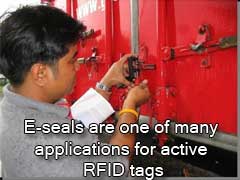Michael Liard, an analyst at ABI Research, notes that despite strong adoption in the military and some other applications, there are many barriers to further expansion of the active RFID market.
“In today’s active RFID landscape, a number of market growth inhibitors and development challenges exist. Among these are numerous proprietary architectures, limited cross-vendor interoperability, hardware price sensitivity, a general lack of cohesion in partner ecosystems, and end-user confusion,” he says.
 The DASH7 Alliance hopes to whittle away at all those barriers. The DASH7 Alliance hopes to whittle away at all those barriers.
Ultimately, DASH7 will have a lab(s) that will certify various tags and readers as meeting its interoperability standards. Those devices that meet the certification requirements will be able to communicate with each other and with common networks.
One proposal has been made to house the first such lab at The University of Pittsburgh.
Different Application-Specific Standards are Required
Laird says the interoperability standards and certification will cover several areas:
- Basic interoperability: Ability for common networks to use readers and tags from any vendor
- Low-frequency wakeup interoperability: Standards for signals that “wake up” an active tag, causing it to broadcast its data
- Sensor interoperability: Similar initiatives for active tags that are connected to sensors, such as those used to monitor environmental conditions inside a container
- Cargo security interoperability: Standards related to so called “e-seals” of cargo containers that indicate whether a container has been tampered with during logistics processes after it has been sealed.
The DASH7 web site notes that “The goal of DASH7 technology is to be simple, elegant and reliable for handling bursty, light-data, asynchronous, transient usage models,” or “BLAST”.
That means the standards must be tightly tuned for dealing with inherently mobile devices that need to upload small bits of information reliably, though it will also support non-mobile fixed devices as well.
Vendor and End User Members
Membership in the DASH7 Alliance currently contains a strong mix of both technology vendors and end users of active RFID technology. On the vendor side, in addition to Savi, are companies such as Identec Solutions, Analog Devices, Texas Instruments, Unisys, and others.
On the end user side, members include Dow Chemical, Michelin, Lockheed Martin, and Northrop Grumman. The US Dept. of Defense is listed as an advisor to the alliance.
The organization expects to issue its first certificates of DASH7 Alliance compliance sometime this year. Only members of the alliance can actually receive a certificate for their equipment, and there is currently no federal requirement for DASH7 Alliance certification from vendors.
Do you think something like the DASH7 Alliance is needed? Why or why not? Do you think a standard such as this will ultimately bring system costs down? Let us know your thoughts at the Feedback button below. |